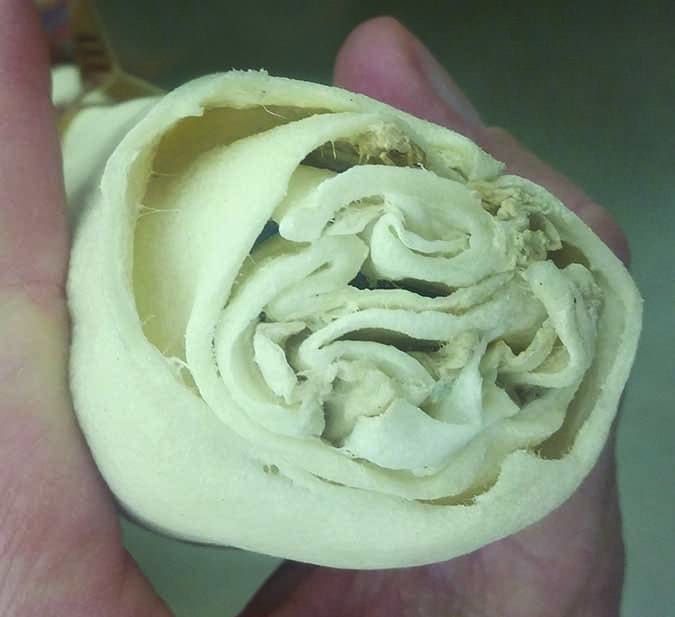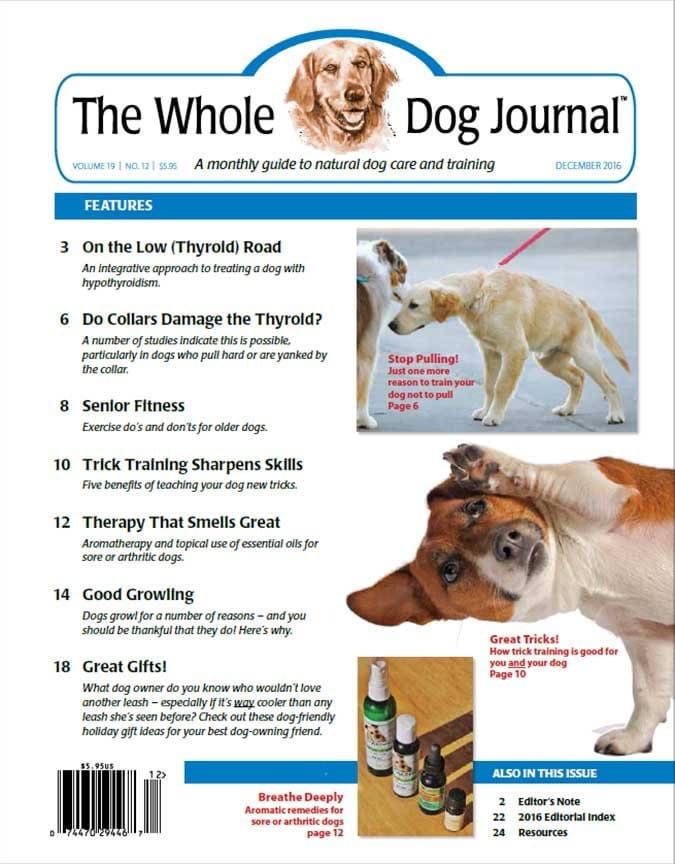We’ve never published a dog gift guide before. But with the holidays coming up, we thought we would arm you with our best suggestions for Christmas and Hannukah gifts for dogs. After spending three days at Superzoo, a gigantic trade show for pet-industry retailers, we came home with so many brochures and fliers and dog product samples – and were so excited about some of the novel, useful, and fun products for dogs we saw there – that we had to share some of the best dog products we found with you. Some of these products will make great stocking stuffers for dogs – others your dog can unwrap under the Christmas tree. We hope you get some ideas for great gifts for dogs and all the dog owners you love!

Gold Paws Series Stretch Fleece Coat
$20 to $36 depending on size
Gold Paws Series
Clackamas, Oregon
(503) 387-6920

Simply put, this is the nicest dog coat we’ve ever seen for warmth, fit, and comfort. Gold Paws Series makes its Stretch Fleece Coat from a buttery-soft, four-way stretch fabric that moves with your dog, no matter how active or exuberant he is. The fabric is light, adding just enough warmth without the possibility of overheating even an active dog. The design is well-tailored, so even though the coat has no bothersome zippers, Velcro, snaps, or straps, it stays on the dog without shifting, bunching, or rubbing. We threw a toy for our model for an hour, and didn’t have to adjust or straighten his coat even once.
The company is located in Oregon, and all of its products are sewn in the U.S., with fabric milled just for Gold Paw Series in a bluesign-certified mill (which ensures the mill is audited for energy, water, and chemical usage to help achieve long-term environmental improvement). That’s going the extra mile to do the job the right way.

This coat comes in 15 sizes, ranging from size 2 (for dogs who measure four inches or less from collar to tail) to 30 (for dogs who measure 29 inches or longer). If your dog is an odd size, for an extra $10, the company will make the coat to custom dimensions. The coats slip over the dog’s head, and easily stretch to accommodate maneuvering even the longest limbs through the arm holes. It’s available in 14 solid colors and four patterns (one leopard, three plaid).
Dogs in the coldest climates may benefit from the Duluth double Fleece, essentially a two-layer, reversible version of the same Stretch Fleece coat. The Portland Pullover is the same design with a waterproof and dirt-repellent shell.
Look on the company website for a retailer that carries these coats; once you feel the fabric, you’ll be a buyer.
Sleepypod’s Yummy Travel Bowl
$30-$40
Sleepypod
Pasadena, California
(877) 763-6963
A $30 dog bowl? Have we lost our minds? Nope! We found the first travel dog bowl we don’t ever want to live without.
It’s actually three pieces that fit together, allowing you to bring along a bowl of water, as well as a serving of your dog’s food, and keep them separate and secure. When you arrive to your destination, you pull apart the pieces so that the food and water can be served in their respective sections. And the water section of the bowl has a spill-resistant design, with a wide rim that keeps water from sloshing out (or being lapped out by a sloppy drinker). But wait, there’s more!
Removed and turned upside down, the lid serves as an extra bowl with an attached “saucer.” Pour a little water in the “saucer,” you now have an ant-proof dog food bowl.
If you fill the water bowl and freeze it, you can either allow it to melt during the day, keeping the water fresh and cold, or use it to keep your dog’s raw diet (stored in the food section of the bowl) fresh and cold for a feeding later in the day. Wow!
The bowl is made silicone, a, FDA-approved food-grade, baby-safe alternative to BPA-containing plastics. Plus, , silicone is freezer-, microwave-, and dishwasher-safe!
The Yummy Travel Bowl comes in two sizes; both are three inches deep but the smaller size is six inches wide and the medium is 7 1/2 inches wide. (The medium size is $10 more.) Both sizes are available in five attractive jewel-tone colors. We like to mix and match them.
We can no longer imagine spending a day in the car (or a night in a hotel) with our dog without one or two Yummy Travel Bowls along for the ride!

Planet Dog’s Orbee-Tuff Squeak Ball
$16
Planet Dog
Westbrook, Maine
(800) 381-1516
We’ve long been fans of the Planet Dog Orbee -Tuff Sol ball – or rather, we should say, the past two generations of our dogs have been fans. Planet Dog got the “mouth feel” of this dog ball just right to suit all the dogs we know: not so hard that the dog can’t squish them as they return from a retrieve, but not so soft that they get chewed and ground between the dog’s molars, either. That makes for a very short-lived toy!

But the company has outdone itself with its new Squeak ball. At three inches in diameter, it’s large enough for most dogs to hold and fetch comfortably, but also small enough that all but the tiniest dogs can get chomp down hard enough to make it loudly SQUEAK! Our dog Otto, a serious squeakaholic, just about went off the deep end in squeaking bliss with this ball.
The Squeak ball comes in just two colors, blue and orange. Like all Orbee-Tuff balls, Squeak is made in the U.S., non-toxic, durable, bouncy, chewy, buoyant, and always 100% guaranteed. But this is the only one that squeaks!!
Also, it’s not just the fact that the ball squeaks that makes it special, it’s how Planet Dog made the ball squeak that’s extra cool. A patent-pending squeaker is built right into the ball; it’s not a separate piece that can be “chewed out of” the ball.
At a suggested retail price of $15, this is a ball that you spend the time searching for when it goes astray in an errant throw. But you can feel good about spending your hard-earned cash on Planet Dog goods. The company gives two percent of every sale to the Planet Dog Foundation; more than $1 million has been given in the past decade to support the Foundation’s mission : promoting and supporting assistance dog organizations.
Dogs who prefer a harder, less squishy ball might prefer the Orbee-Tuff Diamond Plate ball or the original Orbee ball – the one with the raised facsimile of the continents. But for dogs who like to chomp a bit, we’d recommend filling their stockings with Sol or Squeak balls for a raucously happy New Year (and maybe some earplugs for their humans!)
Wholesome Hide’s Super Thick Retriever Rolls
$10
Wholesome Hide
Dolton, Illinois
(888) 872-1110
Some of you don’t approve of giving your dog rawhide to chew, and that’s fine. The vast majority of rawhide chews on the market are horrible, anyway. They are generally either made of tiny scraps of rawhide glued together with dog-knows-what, or made from foreign-sourced hides that have been soaked in dog-knows-what chemicals in an effort to knock down the bacterial count. Your dog is better off without this sort of chew!
But what if we told you that there is a domestic manufacturer of rawhide chews, a company that uses fresh, refrigerated hides and nothing stronger than peroxide to clean and preserve them? And what if we told you that this company offers one product in particular that is made from a single sheet of rawhide – one large square sheet that is rolled up, without any little pieces of scrap hiding inside?

That’s the holy grail of rawhide chews, because a dog has to chew and chew to remove even tiny pieces of hide. True, you don’t want a dog eating a lot of it in any one session. But because it’s impossible to swallow large pieces, and it takes so much work to remove tiny pieces – and given the quality of the materials and manufacture – we feel confident that this is the safest rawhide chew out there.
We don’t recommend giving dogs rawhide as a regular thing throughout their lifetimes. But when your dog is seriously teething, from about six months through his young adulthood, there truly is nothing more satisfying to chew. For more information on rawhides, see “Finding the Right Rawhide Chew,” (WDJ, May 2009).

As with all things that you give a dog to chew, you need to limit his time with the Retriever Rolls, and supervise, supervise, supervise. Take the roll away and dispose of it when it gets anywhere close to small enough to be swallowed. With Woody here, that’s about three or four inches long; a small dog could maybe be trusted with it down to one or two inches.
We’ve found the Rolls in quality independent pet supply stores; there is a list of retailers on the Wholesome Hide website. We’ve also ordered from an online retailer who sells 10 rolls for $100. That should get Woody through the rest of his adolescence!
West Paw Design’s Holiday Toys

0)]
Heyday Beds – $80 to $160
Stuffed Holiday Toys – $11 to $16
West Paw Design
Bozeman, Montana
(800) 443-5567
West Paw Design is another highly reputable pet company with a penchant for producing creative toys and other products for pets. But when we saw their line of stuffed Holiday Toys, we were initially less than impressed; the plush reindeer, bones, pine trees, stars, and bears seemed like your average stuffed toys – something we’d be picking up the pieces of in 15 minutes or so after Woody started playing with them.
But not only did the toys survive session after session of rough play (including tug of war between Woody and a puppy), after a trip through the washing machine, they looked nearly good as new! The Holiday Toys are tougher than they looked. Well, that’s what we would have expected from West Paw: good materials and good workmanship, and always handcrafted in Montana, U.S. of A.

1)]
Most of the Holiday Toys come in two sizes, small and large, and there are a dozen different designs to choose from. West Paw also offers a number of non-holiday-themed stuffed toys to choose from, including cute flamingos, giraffes, and other animals in their “Floppy Dog Toys” line.
If you are looking for a more significant gift than stocking stuffers, don’t overlook West Paw Design’s wide variety of dog beds. Their luxurious yet durable beds come in crate friendly sizes. West Paw Design’s Heyday Bed Collection features low-profile, pillowy bolsters and double-stuff bases – not the thinly stuffed sort of beds that the giant chain stores tend to carry. These beds are truly comfortable, attractive, durable, machine-washable, and dryer safe.

2)]




























